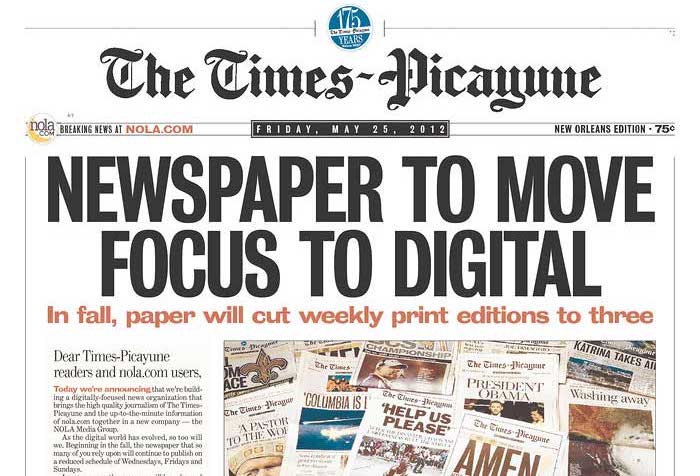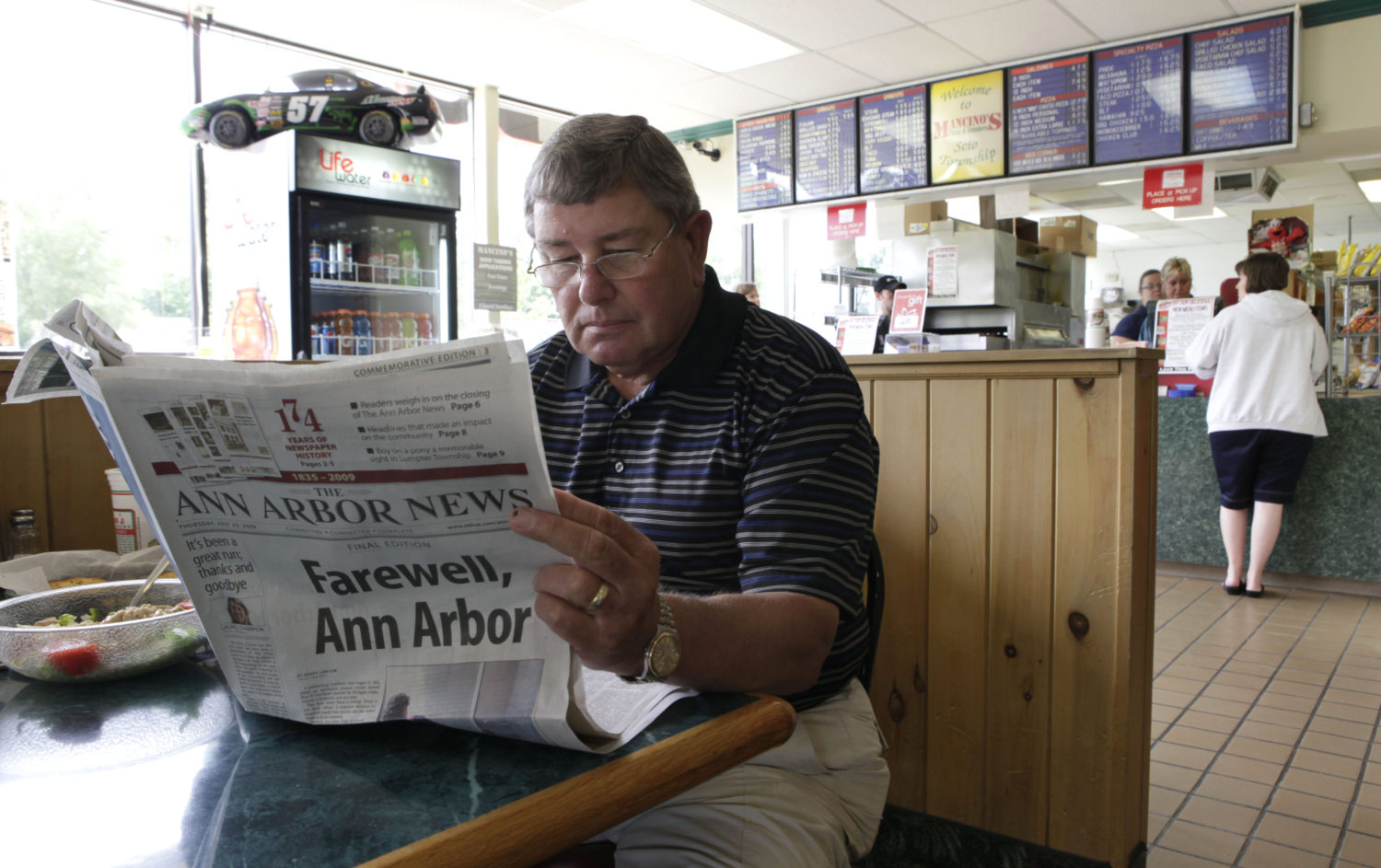Advance Local newspapers shocked the industry, to put it mildly, when it announced in May 2012 that the Times-Picayune in New Orleans was dropping print editions four days of the week. Henceforth its lead news product would be digital at NOLA.com.
More than a few Big Easy residents loudly bemoaned the change — what would they read with their morning coffee and beignets? The New York Times swooped in declaring in the lead of a long story that Advance “had buckled under the pressures of the modern newspaper market.”
Worse, NOLA.com attracted a competitor in short order, a New Orleans spinoff of The Advocate of Baton Rouge. The new publication’s principal selling points were Louisiana ownership and seven-day print delivery. With the backing of a wealthy owner, The Advocate, with a serious news agenda, has persisted on into 2019.
Significantly, almost no one in the industry has followed the Advance digital-print playbook now rolled out in all the company’s 25 local markets. Not Gannett, Not McClatchy. Not Tribune. Not Hearst.
Bob Dickey, who is retiring this year as Gannett CEO, told me in the halls of an investment conference soon after the change that he considered reducing frequency to be bad business. Do you really want to tell the most loyal readers they can get along without the product several days a week?
The industry consensus now seems to be that print, with accelerating revenue losses, is on a slow fade. A pullback, even to offering only the Sunday edition in print, they say, will come eventually. But they still think Advance pulled back too soon.
Conversely, Advance has hardly modified the 2012 plan at all (offering compact street editions, for instance, in several markets including New Orleans on some of the weekdays it does not deliver).
“We made mistakes, a lot of them,” Randy Siegel, president of Advance Local, told me in one of a pair of long interviews, “but we are pleased with our progress and happy with where we are.”
Several editors I spoke with went a step further. The deep-end-of the-pool approach, said Mark Lorando, editor of NOLA.com and the Times-Picayune, quickly put the agonizing newsroom culture change of digital transition, protracted at most papers, in the rearview mirror. That, in turn opened the way to next-generation initiatives like a big Times-Picayune collaborative investigation with The New York Times on Louisiana’s coastal erosion.
“I count every dollar saved on production and delivery as potentially going to more journalism,” Lorando said.
Advance Local is owned by the Newhouse family, whose other holdings include Condé Nast and the lucrative American City Business Journals. Because the company is private and does not disclose results, the complicated math of assessing financial positives and negatives is conjectural. But with some fresh statistics president Siegel provided me, here goes.
- Print circulation — Yes, it is down. Both in volume and revenue, Advance tracks two to three percentage points a year worse than the industry average, Siegel said. Checking results for half a dozen newspapers — two of Advance’s, four in similar markets, I found no reason to question that number. Nearly all had lost half or more of their paid print daily and Sunday over the last six years. Advance’s Oregonian in Portland did worse than that — down to about a third of its earlier daily total, a little better on Sundays.
- Print advertising — Siegel was less specific but said that the great majority of ads, largely missing in action on the days discontinued, simply moved to another day. Of course, Advance has also shared in the industry pattern of deep, continuing print ad declines.
- Digital audience — Monthly uniques have increased from roughly 25 million in 2012 to 55 million last year, he said.
- Video has gone from almost zero to two billion views in 2018. Similarly social media on the four big platforms went to 14 million followers and more than 200 million interactions in 2018.
- According to a Nielsen Scarborough measure, Advance publications had five of the top eight sites in digital audience household penetration, Siegel said. The Post-Standard in Syracuse, at 28 percent, is No. 1.
- The sites have always been free. So in an era when most regional papers and groups have been trying for several years to build a revenue stream with digital subscriptions, Advance is still at the starting gate. It did begin piloting a soft paywall at The Post-Standard last fall — perhaps a signal of retreat from going all free.
- Advance has typically run 5 to 7 percent ahead of the industry in digital advertising, Siegel said. Given the ferocious competition from platform companies since 2012, however, it is hard to imagine that the softening of prices and volume hasn’t dashed Advance’s hopes going in.
- Siegel declined to give profitability figures but did say 2018 has been the best year financially since the digital pivot started. For planning purposes Advance is looking at a 10-year cycle so a full review is coming in 2022.
- Siegel also declined to quantify savings from reduced print frequency. They certainly must now total in the tens of millions for production and delivery. And news staffing needs for digital are typically less than print.
I was unable to find detractors who would speak on the record. One former Advance executive, who asked for anonymity, did describe the switchover in an email as “a disaster across the board.”
Jim Moroney, CEO of A.H. Belo and publisher of The Dallas Morning News, now retired, was highly critical from the start, both privately and in public, of Advance Local’s swing away from print. He thus became a sort of spokesman for industry skepticism.
Moroney’s main point was simple math — at the low cost per thousand impressions that digital ads fetch, increasing volume could not, by itself, support a strong news operation. (Siegel said that he was aware of Moroney’s attack but preferred not to reply.)
Terry Egger, now publisher of The Philadelphia Inquirer, quit as publisher of The Plain Dealer in Cleveland in 2012, saying that he had opposed dropping print days as the move was being planned and thought Advance should get a new publisher on board for the changes. Egger declined to amplify in an interview.
Another former executive suggested a middle ground. Yes, Advance deserves praise for getting early to where the industry is now, 90 percent focused on building both digital news and digital revenue. But, perhaps because community leaders are an older demographic, cutting back print frequency has meant sharply cutting back the newspapers’ influence.

The company-wide rollout began in 2012, but the plan took shape much earlier — in Ann Arbor in 2008. Stefanie Murray, now director of the Center for Cooperative Media at Montclair State University, was part of the small team detached to the project (two others are now top Advance Local executives and a fourth, Amalie Nash, later became editor of The Des Moines Register and now executive editor of local news for Gannett’s USA Today Network.
By the time AnnArbor.com was ready to go the next year, Murray wrote the announcement story for the Ann Arbor News. She and a skeleton crew moved to modest quarters in a plain office building with a failed coffee shop on the ground floor (for a while used as a walk-in center to converse with community members).
“They gave us nothing, not even desks,” Murray recalled. “Tony Dearing (another of the start-up team) had to go out and buy some notepads and pens … I guess they wanted to be sure we would think like a startup.”
Murray’s career path took her to executive editing roles at Gannett and then to the Montclair State job.
“I’m an outsider now, so I don’t see the financials,” she told me, “but I would call (the new publishing pattern) a mixed success — leaning toward success.”
Like NOLA.com’s Lorando, she sees Advance adopting an accurate and tough-minded take on print’s decline when most in the industry would not admit that to themselves, and so getting fast to what should be done digitally instead.
On the other hand, in Ann Arbor, and in the wider rollout too, Murray said that Advance vastly underestimated resistance from staff and readers. Another former executive theorized that as a very private company, Advance did not have much of a sense (and still doesn’t) of how to do public relations or when that discipline is necessary.
With the industry’s print ad and subscriber revenues continuing to tank, Murray said, “my guess is that you are going to see it (the changeover) happen a lot of places in the next several years.”
When I spoke with Michelle Holmes, the high-profile vice president of content of Al.com since 2013, she had started a new job focused on product extensions for the entire chain and was just back from a week “taking meetings,” as they say, in Hollywood.
Holmes had figured in a 2013 story I did about how, for all the talk about digital transformation, very few top editors at metros with strong digital backgrounds were put in control. Holmes fit the unusual profile, having done a year as a Knight fellow at Stanford and having worked briefly on a livestream startup in San Francisco before jumping to Advance.
It took something special, she told me, to induce her to leave California and move to Alabama. She figured the new job would “free me up to have room to experiment, to try a lot of things.”
Holmes’ tenure has included a Pulitzer Prize for commentary last year for political columnist John Archibald and forceful front-page editorials on the Roy Moore/Doug Jones senate race at Advance’s three papers in the state (Birmingham, Huntsville and Mobile). The site’s video coverage of the special Senate race won a top prize from the International News Media Association. Plus Holmes was a lead in launching Red Clay Media, a collection of light digital features on Southern culture that quickly became a social media hit.
Alabama is one of several states (Michigan and New Jersey are others), where Advance’s digital site is branded statewide rather than by city.
“I think that helps us get a perspective on the statewide through-line of issues,” Holmes said, “It’s an expansion of how we think … and it gets us to really good stories on systemic problems.”
Also if the industry goal now is reader/user engagement, print editions and a site are too narrow a frame, she believes.
“We need to work in podcasts, TV, video and VR, (and) to build new brands and relationships”
That is the focus of the new job as head of partnerships she began in June, turning over the reins of Al.com to Kelly Ann Scott.
Five years of transition for Al.com has been a balancing act, Holmes said. “We still cover the Mobile City Council … but we needed to get beyond narrow geographical boxes … dropping zoned editions that never really helped readers”.

If New Orleans has been the leading theater for the drama of reducing print frequency, editor Lorando has been in the line of fire all six years. In his mid-50s, Lorando is a Times-Picayune lifer who was features editor before the change, managing editor after and promoted again when longtime editor Jim Amoss retired in 2015.
Don’t get Lorando wrong — he is still a print fan. We spoke just after the Saints had been hosed by a bad call in the NFC championship game and he thought the event had been especially well memorialized in the Times-Picayune Monday front page print headline: “REFFING UNBELIEVABLE.”
“I have the same sense of loss … there’s that (morning) ritual that is no longer there,” Lorando added. “I miss those days.”
Still, “in retrospect six years later, I’m grateful we moved as fast as we did … We paid a price in vitriolic criticism,” he said. “The print nostalgists pounded us … But digital quickly became the core of the operation … not just a desk or a department.”
There have been a few course corrections. After the Advocate came to town, street print editions were restored three days a week. NOLA.com, like AnnArbor.com, began with a blog-style presentation — story after story stacked chronologically. That lingers, but is now relegated to the left rail, opposite a more conventional home page where stories are displayed with a sense of hierarchy.
Moved to the top two floors of a downtown office building with a custom-built design for digital operations, Nola.com eventually sold the remainder of its lease and relocated to more modest quarters with easier parking.
But all told, staying the course, Lorando argues, has been the ticket “to how we preserve local news.”
“I’m amazed that we (in the industry) are still having a conversation about print frequency,” he said.
As a reporter and analyst I find that we are indeed are still having that conversation — and it is not that far along. The Pittsburgh Post-Gazette discontinued a home-delivered print edition two days a week last summer, but otherwise only much smaller papers have embraced the trend.
At the big annual industry Mega-Conference next month in Las Vegas, the final session the final day was scheduled to be a discussion/debate on print frequency. That has since been canceled in favor of a talk on “How Technology Can Transform Your Customer Experience.”
My guess is that it will take at least another year or two of terrible financial results for the Advance way to become more common practice.
Correction: The original version of this story cited the wrong headline in the Times-Picayune for the Saints loss to the Rams. “EXPLETIVE. EXPLETIVE. EXPLETIVE.” was for the team’s playoff loss a year ago to the Vikings. Editor Mark Lorando emailed to say that his career goal is to write a memorable headline after a Saints win. Also Stefanie Murray’s center at Montclair State was misstated. This story was also updated to correct Jim Amoss’ retirement date. We regret the errors.










